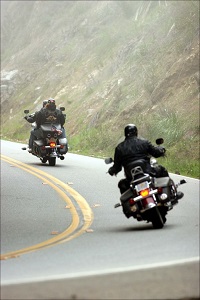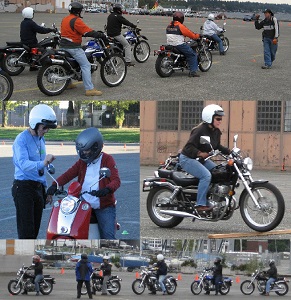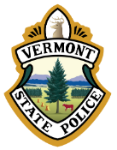 Over half of all fatal motorcycle crashes involve another vehicle. Most of the time, the motorist, not the motorcyclist, is at fault. There are a lot more cars and trucks than motorcycles on the road, and some drivers don't "recognize" a motorcycle – they ignore it (usually unintentionally).
Over half of all fatal motorcycle crashes involve another vehicle. Most of the time, the motorist, not the motorcyclist, is at fault. There are a lot more cars and trucks than motorcycles on the road, and some drivers don't "recognize" a motorcycle – they ignore it (usually unintentionally).- Because of its small size, a motorcycle can be easily hidden in a car’s blind spots (door/roof pillars) or masked by objects or backgrounds outside a car (bushes, fences, bridges, etc). Take an extra moment to look for motorcycles, whether you're changing lanes or turning at intersections.
- Because of its small size, a motorcycle may look farther away than it is. It may also be difficult to judge a motorcycle’s speed. When checking traffic to turn at an intersection or into (or out of) a driveway, predict a motorcycle is closer than it looks.
- Motorcyclists often slow by downshifting or merely rolling off the throttle, thus not activating the brake light. Allow more following distance, say 3 or 4 seconds. At intersections, predict a motorcyclist may slow down without visual warning.
- Motorcyclists often adjust position within a lane to be seen more easily and to minimize the effects of road debris, passing vehicles, and wind. Understand that motorcyclists adjust lane position for a purpose, not to be reckless or show off or to allow you to share the lane with them.
- Turn signals on a motorcycle usually are not self-canceling, thus some riders (especially beginners) sometimes forget to turn them off after a turn or lane change. Make sure a motorcycle's signal is for real.
- Maneuverability is one of a motorcycle's better characteristics, especially at slower speeds and with good road conditions, but don't expect a motorcyclist to always be able to dodge out of the way.
- Stopping distance for motorcycles is nearly the same as for cars, but slippery pavement makes stopping quickly difficult. Allow more following distance behind a motorcycle because it can't always stop "on a dime."
- When a motorcycle is in motion, see more than the motorcycle – see the person under the helmet, who could be your friend, neighbor, or relative.
- If a driver crashes into a motorcyclist, bicyclist, or pedestrian and causes serious injury, the driver would likely never forgive himself/herself.
General Guidelines For Riding A Motorcycle Safely
Be visible:
- Remember that motorists often have trouble seeing motorcycles.
- Make sure your headlight works and is on day and night.
- Use reflective strips or decals on your clothing and on your motorcycle.
- Avoid riding in the blind spots of cars and trucks.
- If possible, flash your brake light when you are slowing down and before stopping.
- Have an escape route in case a motorist doesn’t see you and violates your right-of-way.
Dress for safety:
- Wear a quality helmet and eye protection. A full-face helmet provides the best protection.
- Wear leather or other sturdy, protective clothing (jacket and pants); over-the-ankle boots; and gloves.
- Bright clothing and a light-colored helmet increase the chances of being seen.
- Dress for a crash as well as for the ride.
Apply effective mental strategies:
- Constantly search the road for changing conditions. Use the Search-Evaluate-Execute strategy (SEE) to assess and respond to hazards before you have to react to an emergency.
- Give yourself space and time as you search for traps and escape paths.
- Give other motorists time and space to respond to you.
- Use lane positioning to see and be seen.
- Search for vehicles that may turn across your path, especially at intersections.
- Use your turn signals for all turns and lane changes.
- Ride as if you’re invisible.
- Don't ride when you are tired or under the influence of alcohol or other drugs.
- Know and follow the rules of the road.
Know your bike and how to use it:
- Study your motorcycle's owner's manual and make a habit of doing a pre-ride check.
- Get formal hands-on training and take refresher courses. Call 800.446.9227 or visit msf-usa.org to locate a Motorcycle Safety Foundation RiderCourseSM near you.
- Develop your riding techniques before venturing into traffic, especially emergency braking and swerving maneuvers. Practice often to keep your skills sharp.
- Corner within your skill limits. Aggressive cornering is a major cause of crashes.
- Know how to handle your bike in adverse conditions such as wet or sandy roads, high winds, and uneven surfaces.

